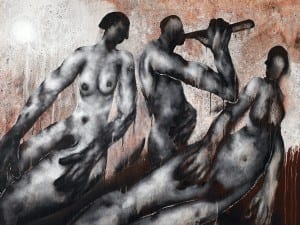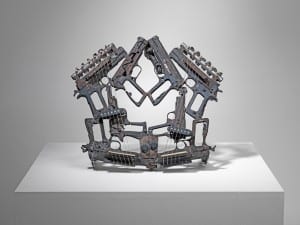Two or three muted, but skillfully executed, pieces of portraiture slowly lead the viewer to paintings with the merest hint of figures, before dissolving entirely into realms of line, colour, light and rhythm. This is just the first room of the major Abstract Expressionism show at the Guggenheim Museum Bilbao, fresh from a groundbreaking run at London’s Royal Academy of Arts. This Frank Gehry-designed, architecturally exciting museum in the uncharacteristically moody city of Bilbao is a high-ceiling labyrinth of glass, steel, marble and stone, enabling an altogether new hanging and a fresh experience for visitors.
The late 1940s in the USA was an anxious time for artists, with the Great Depression behind and the horrors of the Holocaust just surfacing – but also the start of a remarkably fertile new period of dialogue, collaboration, mutual influence and financial recognition. A group of pioneering individuals, many of whom were European migrants to the US who arrived after WWII – Willem de Kooning, Archile Gorky, Jackson Pollock, Mark Rothko, Clyfford Still and Franz Kline to name a few – were breaking away from Cubism and Surrealism to find a new, confrontational and individualistic idiom.
Abstract Expressionism redefined the nature of painting. Household-names Pollock and Rothko, whose hypnotic works prove why they are every bit deserving their fame, are clear examples. Pollock’s 1943 Mural, commissioned by Peggy Guggenheim, has organic, pulsating strokes that seem to capture this transformation of painting in real time. Hints of his later splatter techniques are visible here, but figurative animal forms are also undoubtedly discernible in its negative spaces; co-curator Edith Devaney shares that Pollock dreamt of a heard of buffalo crossing a landscape the night before he began it. And even as Mural seems to mark a lingering interest in figurative form, a piece like Rothko’s four-metre, bright yellow and orange Untitled (1952-3) reminds of its flirtation with total abstraction. Hung dead centre at the end of the first series rooms, it looms ahead as you work your way down the hall, like the mouth of a furnace stealing your attention. Like all of Rothko’s instantly recognisable rectangles of colour, it speaks of the enigmatic, affecting and slightly inaccessible surface of the movement.
Happily, relatively lesser known artists – such as Robert Motherwell and Franz Kline, whose bold, monochromatic canvasses challenge the limits of their frames – are here represented by outstanding pieces that often outshine even the two heavyweights. Klein’s is an ominous but darkly seductive world: the thick, black strokes on white in his Spagna (1961) are mature but violent, whilst his Requiem (1958) has a wall unto itself at Bilbao, to striking effect. Its swirling eddies of black and grey pull the viewer into its tumultuous depths; coming to it fresh from a series of colourful de Koonings, we are abruptly called to descend to a darker emotional pitch. Motherwell, who was the youngest of the group, was by no means the least talented: displayed is the hypnotising At Five in the Afternoon (1948-9), with its high-contrast, thick black shapes on white canvas. Meanwhile, its startling opposite New York City Collage (1959), with its reds, yellows and blues, show his confidence with colour, too, as well as an interest in psychoanalysis.
The colossal scale of some of these canvasses demand the viewer’s immediate attention. Meanwhile, the steel, abstract sculptures of David Smith bring fresh dynamics into each room, offering respite from the paintings’ intensity with their cool surfaces, delicate shapes and subtle spatial arrangements. The leading sculptor from the first generation of the movement allows for a more studied contemplation, and conveys the technical skill and strong art history backgrounds that lay behind much of these artists’ surface frenzy and freedom.
But it is ultimately the paintings that best transport, challenge, and mesmerise audiences. The intensity of the encounter is more accentuated in their Bilbao hanging over London’s, with curators David Anfam, Edith Devaney and Lucia Agirre maximising the qualities of the building. They do this twofold; through thoughtful groupings of artists who would often communicate ideas and share studio space (Pollock and Motherwell, Joan Mitchell and Helen Frankenthaler) and by giving the sheer magnitude of some – like the Clyfford Stills – space to match their emotional weight. Indeed, the Stills are possibly the most impactful of an overall highly affecting exhibition. A stubborn outsider, still physically and creatively distanced himself from the epicentres of the movement in New York and San Francisco, which fuelled the striking originality of his large paintings. His intense and expressive canvasses have an unrelenting vertical movement; slices and fissures of sudden colour; bold blacks; and shapes that seem to continue beyond even his large canvasses.
When one witnesses this remarkable group of works together in the clean, spacious halls of the Museo Guggenheim Bilbao, it feels both as significant an event as it did at the RA, and a slightly different one: further stripped back, and in emphasis of the works themselves in their full, dazzling array. Bringing together more than 130 paintings, drawings, sculptures, and photographs from public and private collections, this exhibition has been a long time coming. Aptly, it has arrived at a time when the open-mindedness and courage of expression demonstrated by these pioneers is as necessary now as ever.
Sarah Jilani
Abstract Expressionism, organised by the Royal Academy of Arts, runs until 4 June at the Guggenheim Museum Bilbao. For more information: www.expresionismo.guggenheim-bilbao.eus
Credits:
1. David Smith, Star Cage (1950). Courtesy of Guggenheim Bilbao.





